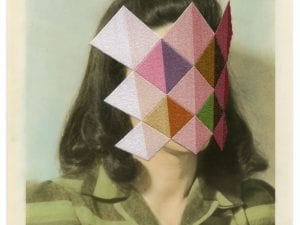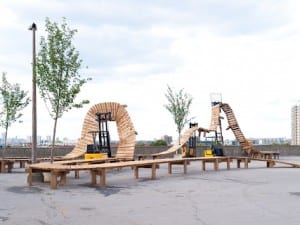At David Zwirner Gallery, London, iconic British painter Bridget Riley presented a fleetingly immersive survey of current and older works; Bridget Riley: The Stripe Paintings 1961 – 2014, in partnership with Karsten Schubert Gallery, culminating in 15 paintings and experimental studies on paper.
The gallery’s perfectly white interior was surreptitiously at odds with Mayfair town-house’s primary function and aesthetics, where prominent residents include Lord Robert Cecil, the 3rd Marquess of Salisbury, who was twice Prime Minister of Britain (1885-1892 / 1895-1902) and Helena Rubinstein, who in 1909 opened her first spa and beauty clinic at the now gallery. But it is precisely this underlying tension between function and aesthetics that allows the formulaic experimentation of colour and perception that has been the driving force behind Riley’s career to exhume a tantalising division between seduction and escapism.
The exhibition was displayed over three floors of the gallery. On the ground floor, Prairie (2003 / 1971) is formed of two large horizontal canvases, with a space in between the canvases, portraying a top-right to bottom-left trajectory of diagonal stripes. A refreshing pallet of snow white, lavender, salmon pink and mint green floats on the wall like a summer breeze, gently enveloping the viewer’s vison. The white of the wall and the canvas stripes created a pulsating effect that gave depth to its metaphysical presence.
In stark contrast to the scale and subtle caress of Prairie, Horizontal Vibration (1961) a small horizontal work, also located on the ground floor, optimized Riley’s most well-known forays in experimentation in optical illusions. Black horizontal lines of varying thicknesses and proximities to one another swell and constrict hypnotically on top of a white background. The vibrations, as riley alludes to the title, are caused by the negative space ricocheting off the borders of the black stripes create a sense of vertigo as it sucks one into an endless horizon. Comparatively, its smaller stature, increases its intensity as it grips the viewer locking shackling them to the spot in which they stand as the illusionary effects take control.
On the first floor, Late Morning 1 (1967) consists of thin white vertical stripes escorted on either side by red highlights and thicker stripes of brown and blue that, as they encroach on the centre from the horizontal polarities, transforms into a damp green. The title and shift in colour towards the centre, echoed the powerful transformation from the darkness of one subconscious state of sleep to the first whispers of light that appear so unadulterated and blinding before they slip effortlessly into the realms of context and association, such is that one become awake and alert fully.
Yet the inclusion of Late gives it’s the festering sweetness and warmth of a southern drawl. This intoxicating allure to one’s changing functionality and perceptions through the day is what makes the work so seductive and so naked to the viewer. It harnesses our understanding of what is around us and invites the audience to revel in our susceptibilities. It leaves one mentally available, prompting exposure to that which is around us and to those feelings and moments we wish to associate and read in-between where the linear patterns and colours pallets superficially exist.
William Davie
Bridget Riley: The Stripe Paintings 1961 – 2014 at David Zwirner Gallery,24 Grafton Street London W1S 4EZ www.davidzwirner.com
Credit:
1. Après Midi, (1981) Oil on linen 91 x 77 3/4 inches (231 x 197.5 cm)
Follow us on Twitter @AestheticaMag for the latest news in contemporary art and culture




